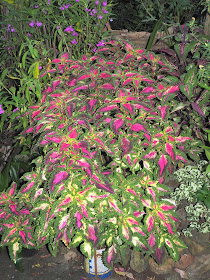October is a crucial month with us in the Philippines. It is still within the rainy season, but the rains seem to be already subsiding. The intense heat of the sun is early for the season. Even at 7 o'clock in the morning it is already hot, you can imagine how it is at noon! Yes what you are thinking is correct, the heat at noon is very unfriendly to both humans and plants. We were joking that we are already at the height of the dry season because of the intense heat. We are already waiting for the typhoon because it comes always with rains, decreasing the heat and refilling our dams for our water in Metro Manila and irrigation water for our major crops like irrigated rice. I hope the cloud formation yesterday is an indication that there will still be incoming rains.
Gardening at home in the province last Sunday morning is already difficult due to the intense sun. I did not go out for butterflies as it is so hot. I already have the wide hat, but still the heat penetrates the head. I did not wear long sleeves, so my arms and hands got darker! Oh how wonderful to be just in the office in an airconditioned room. I said that because i am now already in the office in the big city, very tired but have to work.
Now i am trying to compile some pictures of the blooms and colors i was able to take yesterday. I almost forgot again the date and GBBD.
Most of our colors come from the ornamental foliage like the Coleus blumei. I have 3 varieties and they give wonderful colors to our front yard. Above is the most lively. Can you see the very small tin can at the bottom? That is just where mother planted it, but some stems rooted on the ground, giving the full and wide clump arising from just one plant.
This above 2nd variety of Coleus blumei, mayana in our dialect, is a bit darker with more erect growth habit. It gives more subtle color but definitely gives contrast to otherwise all green surroundings.
The 3rd Coleus blumei variety is totally mauve in color, very dark but lovely too. The contrast against green is very drastic. It is not as prolific as the 1st because the container is much smaller and its other stems did not touch the ground for more roots.
Bothe above and below are from the same plant, just that the top picture are growing on the top portion receiving more direct sunlight. Picture below receives lesser direct light.
This is an ornamental pineapple, which has been growing for 2 yrs now but still not yet fruiting. But it is lovely with just the leaves, so it is more fun.
An Aglaonema hybrid also growing luxuriantly at a slightly shaded area.
Alocasia sp.
Thunbergia erecta, growing inside the hoya house
My post will not be complete if hoyas are not included. They are always there with us giving lots of blooms. Above is Hoya diversifolia i let to climb the lanzones tree. Flowering season started last month and now is the profusion of the blooms. I went to the roof to get a better perspective of them.
This is the lowest portion of the vines of Hoya diversifolia, almost reaching the fence of the hoya house. Some vines reached the top of the canopy and the flowering vines are on the top left side, with their blue sky background.
close-up of the blooms
Hoya blashernaezii
Hoya buotii purple
Hoya bifunda ssp. integra
Hoya nakarensis, a cute little hoya, but floriferous with lots of umbels now
If you think only flowers are blooming in my area, think again. Even a mushroom looks like a flower. It is growing at the growing point area of a coconut. That pointed shoot is the shoot primordia of the young coconut seedling. I shared this with you as i am very fascinated with an unusual mushroom to unusually grow in a very unusual area! LOL
The lanzones tree being conquered by the hoya blooms will not allow itself not be recognized and given attention. Its fruits are now ripening and in 1 - 2 weeks they are ready for human consumption. Can you see some hoya umbels at the small branch at the center of the picture, on top! I guess they are cohabiting in an ecological term called "commensalism", or they are called "commensal symbionts". Hoya benefits from the lanzones, which is not affected or benefitting from it at all.
I hope you enjoyed my colors this October. You cannot feel our intense heat, but at least you can join me in appreciating our garden colors. Thank you so much.



















































